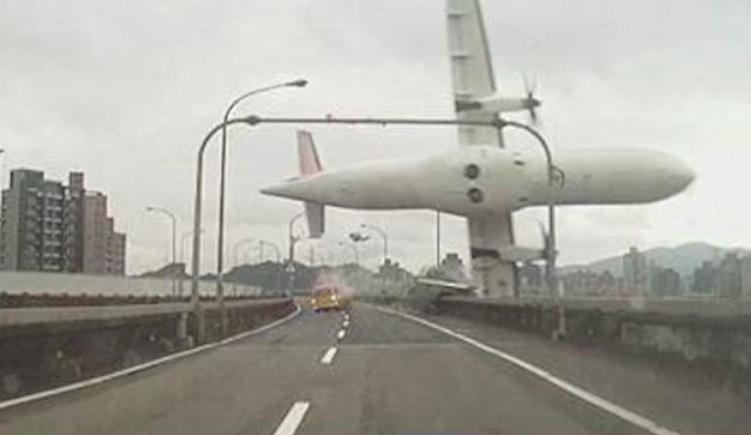By now you’ve seen the story of TransAsia Flight 235: the twin-turboprop ATR-72-600 lost forward momentum shortly after takeoff from Taipei Songshan Airport and crashed about five kilometers later in the Keelung River, after striking a raised bridge section of National Highway 1 and a taxi. If you are unfamiliar with this story, this is the dash cam footage that was captured.
As you can see in the footage, the ATR-72 is flying low and extremely slow when the aircraft stalls and starts to drop. The left wing loses lifting capability and strikes a Volkswagen taxi van and the bridge. It’s currently speculated that the pilot was making a last-ditch attempt at landing in the Keelung River as a last-ditch act to ensure the maximum number of survivors. Out of the 58 people on board, at press time there were fifteen known survivors, and that the occupants of the taxi, while injured, were stable and being treated. Rescuers responded swiftly with boats to assist the survivors and to try to rescue anyone that they could and later in the evening, the fuselage was removed from the river.
The question that is on everyone’s mind is, of course, “What happened that caused this accident?” The ATR-72-212A, registration B-22816, was barely a year old, having been delivered to TransAsia in April 2014. The ATR-72 has been in production since 1988 and out of the 1200 or so built, only fifteen have had accidents. The pilots had over 18,000 flight hours between them. Then there’s the Mayday call that was issued before the ATR dropped off of radar, where the pilot claimed engine flame-out two minutes after takeoff. The ATR would have enough power to fly on one engine if everything is functioning properly, but if there was a different issue (like a fuel delivery issue), then there simply wouldn’t be enough time to glide the aircraft to a better landing.
There is no definitive answer as to what specifically happened to the TransAsia aircraft yet, though that may be answered soon since the “black boxes” were recovered, and any claimed causes for the accident are purely speculation at this point. This is the second fatal ATR-72 crash for TransAsia Airways in less than a year. Last July Flight 222 struck buildings while attempting to land in bad weather at Kaohsiung International Airport in Penghu, Taiwan and is currently under investigation, with the results expected to be released in October, 2015.
























The aircraft dropped its port wing, dramatically. When you loose one engine on a twin, and it doesn’t matter is its a regular engine, turboprop like this one, or a jet, you pull back on the other engine and drop the nose to gain speed. They stayed in a hard climb, which means they had full power to the starboard engine, which would have made the aricraft turn towards the left, which it did. When the wings tilt in a turn, they loose lift, which this did.
I don’t care what mechanical problem the aircraft had, the crash, at least in the respect of where and how it occurred, was pilot error.
Can you realistically “drop the nose” when you’re close to the ground, in an urban area, and in the midst of taking off? You don’t have much altitude to play with & the ground comes up awfully fast.
Looks pretty clear it was in the stall when it came into view. With all the buildings it threaded through, I would like to think the pilot either gave the right engine full power , or pulled it to the left, to try to make the river.
I doubt if it went straight into a building, there would be any survivors.
They saved 15 people.
This is not a view of an aircraft that one wants to see at this altitude
Brian,
Thanks for such a great website! I did not know you also had aviation interest. I was blessed to have a 20+ year career flying for several corporations.
All analysis from the bleachers we sit in is at best, speculation. My viewpoint is that they did indeed lose one engine and possibly mis-handled the aircraft for a reason that fools even seasoned pilot. The adage of “dead foot, dead engine” is reversed when an aircraft has an auto-feather system. The system automatically applies the proper rudder direction and is opposite of what happens without auto-feather.
Dennis, we enjoy aviation around here as well! The most I’ve flown fixed-wing was a Cessna 172, and most of my tech experience is in rotorcraft, but I’ve worked around numerous airframes and have plenty of friends in the community. One thing keeps standing out with this ATR: every time I see the footage, the left engine’s prop keeps catching my eye. Is this the feathering system working or does something look really “off” with that prop?